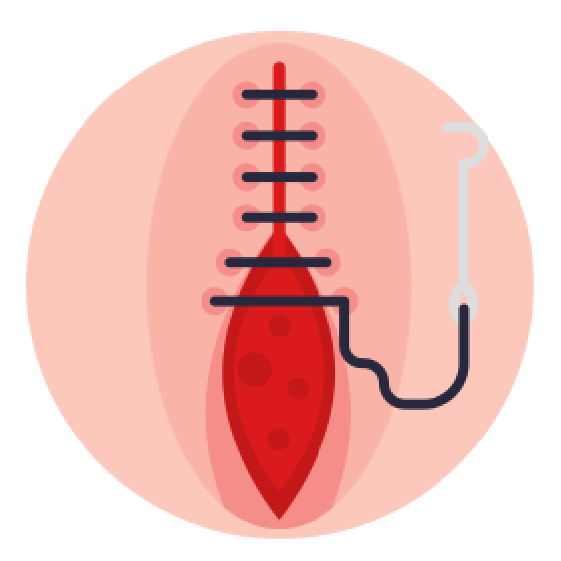Wound Care Clinic
Venous Ulcer Wounds
Venous leg ulcers (VLUs) are a manifestation of pathological tissue changes, appearing as defects on the lower leg, which occur as complications of chronic venous insufficiency (CVI). Chronic ulcers are defined as persistent lower leg sores that do not heal within six weeks, caused by various underlying factors.
VLUs significantly disrupt a patient’s normal life. Successfully treating VLUs requires commitment and collaboration between the patient and healthcare provider. The impact of VLUs on a patient’s overall health is increasingly recognized as a valuable indicator for evaluating treatments, particularly when complete healing is unlikely. Adults with VLUs often experience multiple debilitating symptoms, including pain, disrupted sleep, depression, lower extremity swelling, fatigue, and symptoms associated with leg inflammation (such as redness, localized warmth, discomfort due to high exudate levels, and itching).
According to American Family Physician, venous ulcers, the most prevalent type of persistent lower limb wounds, affect 1% to 3% of the U.S. population. These ulcers typically result from venous hypertension due to issues like venous reflux or obstruction. Risk factors include age above 55, family history of chronic venous insufficiency, higher body mass index, prior pulmonary embolism or venous thrombosis, lower limb skeletal or joint problems, multiple pregnancies, parental history of ankle ulcers, physical inactivity, previous ulcers, severe lipodermatosclerosis, and deep vein reflux. Poor prognostic indicators encompass ulcers lasting over three months, initial ulcer size of 10 cm or more, arterial disease in the lower limbs, advanced age, and elevated body mass index.
Causes and Appearance
Some Aspects of Venous Ulcer Worth Considering
Etiology: Chronic venous insufficiency is the most frequent etiology of venous ulcers. One-way valves in the leg veins weaken or are damaged in this disease, enabling blood to flow backward and pool in the veins. Ulcers may form over time as a result of the pressure and congestion they cause.
Clinical Presentation: Venous ulcers frequently present as shallow, painful, and asymmetrical lesions with a red or yellowish foundation. There might be a weeping or oozy discharge around them, as well as puffy, discolored skin around them. These ulcers can cause severe discomfort and movement problems, and they can be highly painful.
Psychological Impact: Venous Ulcers can significantly damage a patient’s psychological well-being in addition to their physical health. Emotional misery, social isolation, and melancholy can result from pain, discomfort, and ugliness. The emotional wellness of people with venous ulcers must be addressed by medical professionals.
Hazards
The following are the risk factors for developing venous ulcers:

Excess Body Weight (Obesity)

Deep Vein Thrombosis

Paralysis

Minimal Physical Activity

Surgical Procedures (knee replacements)

Presence of Varicose and Spider Veins

Claim your free 20-minute doctor consultation online today!
Book Now ›

Recovery roadmap
Effective Treatment Options for Venous Ulcer
Elevation: Elevating the afflicted leg while seated or lying down is a fundamental step in managing venous ulcers. This practice helps reduce swelling by allowing gravity to assist in the return of blood to the heart. By improving blood flow, elevation can facilitate the healing process and alleviate discomfort.
Wound Care: Properly tending to the ulcer is crucial. This involves cleansing the wound, applying appropriate dressings to promote a moist wound-healing environment, and diligently managing potential infections. Wound care is a cornerstone of venous ulcer management, as it directly impacts the ulcer’s healing trajectory.
Medications: Medications may be necessary in certain cases. Antibiotics are administered to combat infections that can develop within the ulcer. Additionally, topical ointments or creams may be used to stimulate the healing process and minimize discomfort.
Surgery: In severe cases or when other treatments prove ineffective, surgical interventions may be required. These interventions may include repairing damaged veins or removing tissue surrounding the ulcer. Surgery aims to address underlying vascular issues and promote ulcer healing.
Lifestyle Changes: Lifestyle modifications play a significant role in managing venous ulcers. Patients are encouraged to maintain a healthy lifestyle, which includes staying physically active to promote circulation and avoiding prolonged periods of sitting or standing, which can exacerbate venous insufficiency.
Compression Therapy: Compression therapy is a commonly used method for managing venous ulcers. It involves the use of compression stockings or bandages to reduce swelling, enhance circulation, and prevent the recurrence of ulcers. However, it should be noted that compression therapy can pose challenges, such as dealing with wound drainage and ensuring proper application.
Education and Self-Care: Patients with venous ulcers benefit from education on proper ulcer care. This includes keeping the ulcer clean, dry, and shielded from external contaminants. Patients should also be informed about the signs and symptoms of potential infections to seek prompt medical attention when necessary.
Regular Follow-Up: Regular follow-up appointments with healthcare providers are essential for patients with venous ulcers. These appointments allow healthcare professionals to monitor the progress of the ulcer and make adjustments to the treatment plan as needed. They also provide an opportunity for patients to receive guidance on long-term management and potential future treatments.
Prevention
Preventative Strategies

Preventing venous ulcers primarily entails taking proactive steps to manage underlying risk factors. Leading a healthy lifestyle, which includes keeping a suitable body weight and participating in regular physical activity, can significantly reduce a person’s risk. It’s important to avoid spending a lot of time sitting or standing, especially if your job requires it. In rare circumstances, medical practitioners could advise wearing compression stockings to assist normal blood flow in the legs. Additionally, those with a family history of venous disorders should be very cautious and seek medical help right away if they have any early symptoms of leg-related problems. These preventative strategies can significantly reduce the frequency and severity of venous ulcers when paired with early management and appropriate treatment.
Professional Support
Expert psychological consultation services

Chronic Wound
A wound, whether acute (caused by an injury) or chronic (persistent), goes through a typical healing process involving stages of hemostasis, inflammation, proliferation, and remodeling.

Diabetic Ulcers
Diabetic ulcers, most commonly found on the feet, are open sores or wounds. They occur primarily due to poor circulation, neuropathy (nerve damage), and increased pressure on certain foot areas.

Venous Ulcers
Venous ulcers, a complication of venous insufficiency, have a notable impact on an individual’s quality of life. As these wounds can be notoriously hard to heal, understanding their origin and treatment is essential.

Pressure Wounds
Pressure wounds are injuries to the skin and underlying tissue caused by prolonged pressure on specific areas of the body. Understanding their cause, prevention, and management is crucial for maintaining skin health.
Skilled Doctors
Our therapy specialists
Client Inquiries
Institution insights & answers to your questions
Do venous ulcers hurt?
Venous ulcers may indeed be uncomfortable. From little discomfort to severe agony, the degree of pain might vary from person to person.
What possible side effects might venous ulcers have?
Venous ulcers can develop into cellulitis (a skin infection), venous eczema, and, in rare instances, skin cancer if they are not treated. They may have a profound effect on someone’s quality of life.
With a venous ulcer, can I carry on with my normal activities?
It’s critical to heed the advice of your healthcare practitioner. With some adaptations, you may frequently continue with your normal activities, but it’s vital to take action to speed up recovery and avoid aggravation.
Is there a chance that a venous ulcer may return once it heals?
Recurrence is a possibility, yes. To reduce this risk, proper post-operative care and continued venous insufficiency therapy are crucial.
Get appointment
Emergency that Requires Hospitaliszation: Call 911
Privacy Policy and Terms of Use Applied
GET IN TOUCH
Contact us for any inquiries or assistance
(888) 888 8888
info@curativewoundcare.com
Aldine, TX
Service Coverage
Inverness Forest, Greenspoint, Fallbrook, Melrose Park, Hahland Park, Mountwood, High Meadows, Inwood Forest, Westfield, Eastex-Jensen Area, Westbourne, Hopper, Airline Farms
